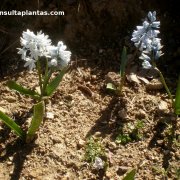Care of the bulbous plant Puschkinia scilloides or Striped squill |
|
The genus Puschkinia, family Asparagaceae, includes 3 species of bulbous plants native to the Caucasus and the Middle East. The species are: Puschkinia scilloides, Puschkinia peshmenii and Puschkinia bilgineri. Common names: Striped squill, Lebanon squill. This species is native to the Caucasus Mountains. They are small bulbous plants that reach 25 cm (9.84") in height. The leaves are tapered and green. The flowers are bluish-white in color and appear in spikes above the leaves. They bloom from late winter to early spring. Striped squill is used in rockery, undergrowth, to create colored spots on lawns, and in pots as indoor plants or for balcony and terrace. Puschkinia scilloides prefers a semi-shade exposure; It can grow in full sun in cooler summer climates. The soil can be a mixture of loamy garden substrate with coarse sand and peat. Planting is done in the first half of autumn, separating 15 cm (5.9") apart between plants. Water regularly so that the substrate is always slightly damp but never flood. Striped squill does not need pruning or fertilizers. Puschkinia scilloides is resistant to the usual pests and diseases. Lebanon squill is propagated by separation of bulbs but will take 3 years to flower. Let the leaves wilt, remove the bulbs and store them in a dry and dark place to sow in autumn at 8-10 cm (3-4") deep. |
Images of the bulbous plant Puschkinia scilloides or Striped squill |
Find plants
Puschkinia scilloides or Striped squill | Care and Growing
© 2025 FavThemes


